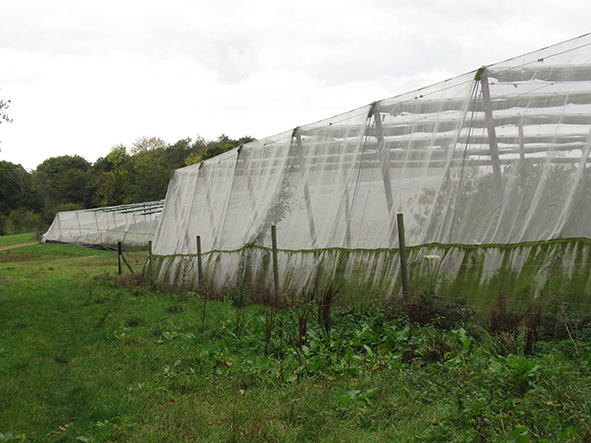- Screen Colours:
- Normal
- Black & Yellow

Above: two fleece-covered fruit farm fields [photographs by John Norman]
Planners are occasionally presented with cases that are not straightforward: some change of use proposals, ideas that border on permitted development, and alterations that have got out of hand. One such case has been taxing planners and conservationists in the Dedham Vale Area of Outstanding Natural Beauty (AONB). The area north of Stoke-by-Nayland is ideal for growing fruit, in particular apples the majority of which are destined to become apple juice, usually under the Copella brand.
As well as apples the Box Valley produces soft fruit (strawberries), cherries and grapes. On the other side of the River Stour at McLauchlans Fruit Farm you can pick-your-own strawberries, gooseberries, redcurrants, blackcurrants, raspberries and sweetcorn. Before the First World War this area was awash with fruit trees but, with the introduction of mechanised farm machinery, arable farming became easier and the trees were grubbed up to make way for cereal crops.
In the twenty-first century things are changing once again and fruit trees are coming back, firstly because the demand for fruit juice is increasing and secondly because planting trees might help save the planet from global warming. It is the demand for commercially grown fruit that is causing the planners a headache. Modern methods of apple production mean that the trees are grown espalier-style, trained along wires, in two-dimensional rather than their normal three-dimensional format.
These wires need support from metal posts, so the shape of the tree is different to those in your back garden. This alone isn’t a major problem in this Area of Outstanding Natural Beauty; most people understand that commercial and agricultural activity must continue and flourish if the landscape, as we know it, is to survive. What is different is that fruit farmers have started surrounding these plantations with white fleece, suspended from 4-metre-high fence posts. Suddenly, and especially when viewed from a distance, the field takes on the appearance of a factory, a warehouse, a massive solid industrial shed – an unacceptable intrusion into the AONB?
Below: Fruit grown under fleece in the distance beyond pylons

The simple question the planners need to ask themselves: is this agricultural use permitted development or is this an essential part of the factory production process (for which planning permission would obviously be required)?
It should be noted that the owners of the fruit farm in question are co-operating with the planners, and with the locals to reduce the impact of their developments on the environment, suggesting some fast-growing external planting alongside the external fleece fence, and the user of timber, rather than concrete posts. General Permitted Development Orders applicable to agricultural development cover many, but not all, developments on agricultural land.
It is not much of a counter effort by The National Association for Areas of Outstanding Natural Beauty but they have instigated a scheme with volunteer groups to plant traditional fruit trees on areas of public land, a selection from five different varieties. Each of the young trees are currently approaching six feet and will grow up to fifteen feet high – and wide – as they mature. The crop will become a community asset. A brilliant idea for wide road-side verges but hardly a replacement for the intrusion planned by the commercial growers.
John Norman
